ARTICLE
Old people everywhere
6:15:03 25 October 2023
52°22′22″N 04°53′37″E
The following article first appeared on Medium. It is republished here with the permission Menno Cramer, its author and a recent attendee at the October Experience Course. The course ends with much talk about Christopher Alexander et al’s A Pattern Language, and particularly Pattern #40: Old People Everywhere. It’s a personal favourite and source of so much good. Cramer explores that goodness largely by means of a Finnish nursing home that is also a kindergarten. It’s brilliant, on so many levels.
Christopher Alexander’s Pattern #40 encourages designs that mix different generations together, such as the elderly and children, in everyday community life. A successful example is found in Finland, where a combined space for a nursing home and kindergarten has been created. This design helps the elderly feel more connected, happier, and healthier by sharing spaces and activities with children, and it allows for the exchange of wisdom and experiences between generations.
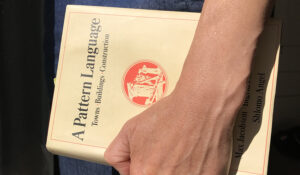
The patterns from by Christopher Alexander goes beyond usual architecture rules, blending design with natural human behaviours and society’s patterns. It focuses on creating environments that support community living and human connections. Pattern #40, specifically, emphasises including the elderly in community spaces, promoting interaction between different generations, allowing elderly wisdom to be a natural part of daily community life.
Pattern #40 is a compassionate call to society to redesign public spaces with inclusivity at its heart. Alexander’s insightful observation underlines the importance of ensuring that the elderly are not excluded, segregated or marginalised within our communities. This pattern emphasises the creation of environments where old people naturally become part of the daily life of a neighbourhood, promoting intergenerational interactions and the sharing of wisdom between the old and young.
The symbiotic relationship between the elderly and children in intergenerational living spaces has many health benefits for the elderly. Sharing spaces with children can become a source of vitality, encouraging more physical activity, enhancing mental engagement, and fostering emotional well-being in the elderly. The presence of children infuses an energetic rhythm into their lives, often inspiring enhanced mobility and participation in various activities. For instance, the simple joys of watching children play or engaging with them in shared tasks like baking or art encourage the elderly to move more, inadvertently improving their physical health and agility.
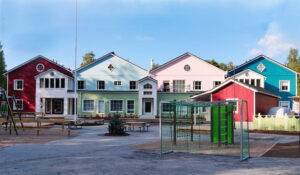
Shared meals become lively gatherings rather than solitary experiences, encouraging the elderly to eat more mindfully and enjoy a diverse array of foods in the delightful company of enthusiastic young eaters rather than the same can of beans each day.
Psychologically, the elderly also experience benefits from this companionship. The innocence and joy of children act as powerful antidotes for feelings of loneliness and isolation often experienced by the older population. Children’s natural curiosity, their uninhibited expressions of affection, and their ability to live in the moment help rejuvenate the mental spirits of the elderly, fostering a happier and more optimistic outlook. Being around children also stimulates cognitive function as the elderly engage in conversations, storytelling, and games, keeping their minds active and engaged.
Ultimately, the mutual presence of the elderly and children in shared living environments becomes a nurturing source of physical rejuvenation, mental stimulation, and emotional warmth, enhancing the overall quality of life and well-being of the elderly.

Implementation strategies, aka now what…
In applying Pattern #40, urban spaces become canvases painted with the rich experiences of the elderly, who bring a sense of continuity, history, and lived wisdom. This pattern encourages the development of spaces that are accessible and welcoming to the elderly, allowing them to participate actively and meaningfully in communal life.
Urban spaces should prioritise walkability, easy access to essential services, and the creation of communal spaces that promote interaction, such as parks, benches, and shaded areas. Ensuring that public transportation is elderly-friendly is also crucial, allowing for mobility and freedom in exploring urban spaces.
In frosty Finland, an innovative fusion of generations breathes warmth and life into the Pattern #40 in an architectural masterpiece by Casagrande Laboratory. The Lamminranta nursing home and a vibrant kindergarten under a single roof, creating a harmonious ecosystem where ages from one to a hundred flourish together.
Senior citizens and children share their days, intertwining moments of joy, curiosity, and warmth. “This is home, we all live under one roof,” asserts the director of the ageing facility. Within its welcoming walls, elderly eyes twinkle as they watch children play in the yard. This from the kindergarten’s manager:“The daycare centre’s group and common spaces are like straight out of the shed (early childhood education plan), and there is a crowd here. Some families with children may also have their own grandparent(s) in the same house and the whole family sees each other at the same time. We do a lot of art and crafts and also use a lot of the common areas of the house. Even now, one group comes here to eat.”
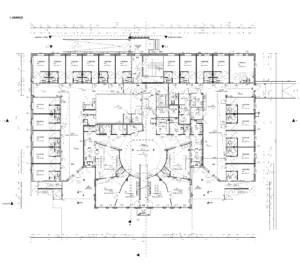
Distinguished by thoughtful colour-coded exteriors and interiors, the architecture blooms as a helpful guide, aiding those with memory diseases to navigate their surroundings with a gentle ease. The words of the care home manager echo the essence of this magical confluence, “It’s really important that we live under the same roof here. The rhythm of children’s little feet and their singing and playing are so important for our elderly people.”
Every corner of this creation tells a tale. Tales of toddlers and the elderly sharing freshly baked buns, engaging in playful activities. The chance encounters, seamlessly woven into the fabric of daily life, have blossomed beyond all expectations, nurturing a space where the hearts of the young and old beat in a symphony of shared rhythms and melodies. “It’s really important,” says the care home manager, “that we live under the same roof here. The rhythm of children’s little feet and their singing and play are so important for our elderly people. And for children this is completely natural — they are not afraid of the elderly, quite the opposite. Many people specifically want to come and bring a drawing, for example, to delight some grandma or grandpa.”
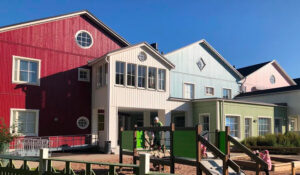
It takes a village
“Omwana taba womoi” — this beautiful expression of collective guardianship and community in child-”caring” — finds an echo in the heartwarming intergenerational harmony witnessed in the project by Casagrande Laboratory in Finland. Much like the African proverb underscores the shared responsibility and unity in raising a child, the integration of elderly care with kindergarten in the Finnish setting heralds a similar confluence of mutual care, shared wisdom, and collective nurturing across generations.
This innovative living arrangement brings to life a modern village where the elderly and the young cohabit, sharing spaces, activities, and daily rhythms. Like the Nona’s in Italy, watching, managing and caring for the children. In this delightful interplay, the children find not just one, but many loving guardians in their elderly friends. They in turn are filled with vibrant energy, curiosity, and joy that the youngsters bring into their lives. It’s a true symbiotic relationship, where the boundaries of traditional caregiving roles blur, giving way to a community that nurtures and is nurtured by every one of its members, regardless of age.
In the essence of “Omwana taba womoi,” every elder in the community becomes a guardian, a storyteller, and a holder of wisdom for every child, while every child brings to the elderly a refreshing fountain of joy, purpose, and the spirited warmth of youth. It is a living canvas where the wisdom of age meets the wonder of youth, crafting a tapestry of shared experiences, mutual learning, and interwoven stories.
Thus, the manifestation of Christopher Alexander’s Pattern #40, in its delightful expression in Finland, aligns wonderfully with the ethos of “Omwana taba womoi,” creating spaces where the village truly raises the child, and the child brings joy, purpose, and continuity to the village, building bridges across generations, and nurturing a community of harmony, respect, and shared guardianship.
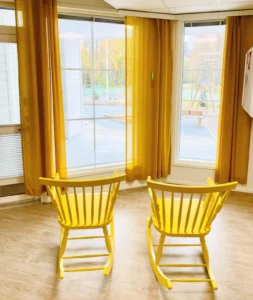
Conclusion
The embodiment of Christopher Alexander’s Pattern #40 in the design by Casagrande Laboratory illustrates the transformative power of architecture that resonates with the rhythms of humanity. Through thoughtful implementation, the design breathes life into the principles of inclusivity, connectivity, and mutual flourishing of generations. It showcases a habitat where the elderly are not mere passive recipients of care but active contributors to the vibrancy and diversity of communal life.
In this manifestation of architectural wisdom, each element — from colour-coded pathways to shared saunas — speaks the language of empathy and consideration, crafting an environment where the soft patter of tiny feet merges seamlessly with the measured steps of age. A constant exchange of energy, wisdom, and pure, innocent joy flows through the interconnected spaces, echoing the premise that in the embrace of community, life blossoms in its richest colours.
Pattern #40, as brought to life in Finland, reveals the profound possibilities of a design that nurtures the essence of human connection. It offers a canvas where the stories of life unfold in their most authentic form, celebrating the diversity of ages and experiences. In the warmth of this intergenerational embrace, we find the past, present, and future, and therein lies a profound lesson for the architects, planners, and dreamers of tomorrow’s communities.
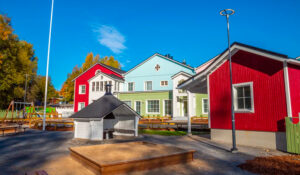
Menno Cramer is passionate about people and design, more specifically how we, as humans, interact with designed objects and services.
All his roles are at the intersection of behaviour and design. In his PhD in Neuroscience & Design, he started to explore the link between designing spaces and how we perceive and are impacted by them: from physical spaces like cities, transport structures and architecture, to digital spaces like websites, apps, and products.
As UX designer and design consultant for start-ups and enterprises, Cramer scopes a wide range of activities and topics. His career is about how we can manage the creation of spaces, products, and services, whilst accurately predicting the experience they inherently generate.
All care home and kindergarten images and drawing © Casagrande Laboratory. Woman and child image courtesy Ekaterina Shakharova on Unsplash.



